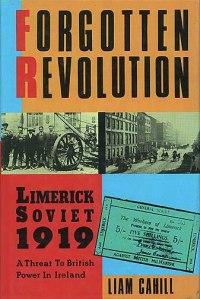A New Year’s note from the author: It’s been a great year for the blog, with views up more than three-fold on 2012. Thanks a lot to everyone who’s read, liked and commented.
This post has been a very long time coming. I haven’t posted in months, but the blog isn’t abandoned, have no fear. For one thing, the posts I’ve made over the past two years are still making me friends and enemies online.
For another thing I’ve had a mad busy few months since when I last posted in August. The holidays gave me a break and let me finally get this post done. Things will be slow but hopefully steady for the next six months, then back on track after that.
From 1917 to 1923 the Irish working class went on the offensive like never before or since. Every year saw an average of 200 strikes and lockouts. Landless labourers and small farmers followed the lead of the working class; at the time some said that the struggle against landlords in those years surpassed the land war. This history has had a curtain of republicanism drawn around it. It has been hidden behind a colourful story of ambushes and assassinations. But Costick in his excellent book on this subject Revolution in Ireland reminds us:
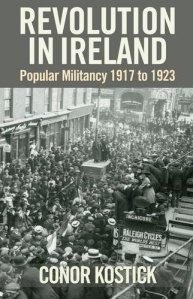 …without the willingness of hundreds of thousands of workers to boycott, strike, demonstrate and protest, the military activity of the 3000 or so IRA members who had managed to obtain guns would have proved insufficient.[1]
…without the willingness of hundreds of thousands of workers to boycott, strike, demonstrate and protest, the military activity of the 3000 or so IRA members who had managed to obtain guns would have proved insufficient.[1]
It was not the IRA guerrilla war on its own that ended British rule in Ireland, though that’s the idea that’s drummed into us in school.[2] It was the masses in southern Ireland, in particular the working class, that made the revolution.
This all came to the fore when the Irish dockers and railway workers refused to handle weapons for the British army. This turned the military situation against British imperialism very significantly. What’s not generally known is that the workers who started this strike were inspired by the British workers who were refusing to handle weapons destined for the hands of the counter-revolutionaries in Russia.
This single fact places the IRA in the context of working-class struggle without which they never would have won. It also places that working-class struggle in the context of the world revolution. This is how we should think about this period.
Huge upsurge in struggle
Like practically every European country, Ireland saw a rise in trade union membership and the number of industrial struggles in  the years leading up to 1914. Following the outbreak of the First World War, membership plunged and strikes disappeared. In the late-war and post-war years the curve rose again. We can look at the statistics for country after country, and we see that towards the end of the war it hits the 1914 high point; in 1919 or 1920 it rises to entirely new heights.[3] The Irish TUC grew from 110,000 to 250,000 members from 1916 to 1920. Most of this growth was down to the ITGWU, Jim Larkin’s union, whose membership grew from 5,000 to over 100,000 in the same period.[4]
the years leading up to 1914. Following the outbreak of the First World War, membership plunged and strikes disappeared. In the late-war and post-war years the curve rose again. We can look at the statistics for country after country, and we see that towards the end of the war it hits the 1914 high point; in 1919 or 1920 it rises to entirely new heights.[3] The Irish TUC grew from 110,000 to 250,000 members from 1916 to 1920. Most of this growth was down to the ITGWU, Jim Larkin’s union, whose membership grew from 5,000 to over 100,000 in the same period.[4]
The first issue of the ITGWU’s paper Voice of Labour claimed in December 1917 that the year had been more significant for the labour movement than the lockout year of 1913. 1917 ended with 25,000 ITGWU members compared to 5,000 in 1916.[5] This was before the great general strikes, before the soviets; the best was yet to come.
Yet today it is 1913, not 1917-1923, which is remembered as Labour’s great “moment” in Irish history. The Irish working class as a political force is relegated to 1913 in mainstream memory, a date safely sealed away from 1916 and 1919-21. In reality, 1917-23 overshadows 1913 by a very long shot in terms of working-class struggle and socialist ideas.
The Russian Revolution
Along with this great working-class offensive came a new international vocabulary: Soviets, Bolsheviks, red guards, red flags. This represents something very deep. Much deeper than, as some argue, simply an attempt to lend some second-hand glamour to otherwise boring strikes for a few percent more here and there.[6] In fact “There was a growing working-class culture […] which openly identified with the Red Flag and drew inspiration from the Russian Revolution.”[7]
These strikes and struggles were so numerous and so intense because a new idea had entered world politics in a spectacular fashion in 1917: the idea that the working class could and should run society, that every struggle was an episode in the fight for the socialist future of humanity.
Churchtown, Co Cork saw repeated factory occupations and protests with red flags prominent, including the classic slogan of Karl Marx, “Workers of the World, Unite!” Farm labourers’ struggles in Waterford began with the “Battle of Femor”, a hand-to-hand street battle that took place under the red flag, and escalated to a two-week strike in 1923 in which the (Irish Free State) army imposed martial law and suffered from ambushes and gunshots. Farmer “White Guards” and labourer “Red Guards” abducted, beat up and killed each other in a low-level civil war.
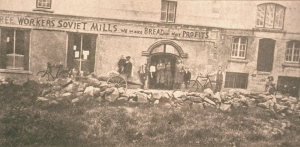 Aghada, Co.Cork, was patrolled by “Red Guards” for six days in 1919. Cork port saw a workers’ occupation in September 1921 in which the ITGWU organiser in the leadership of the struggle addressed strikers as “Friends, comrades and Bolsheviks.”[8] Even in Galway, a town viewed as conservative next to Limerick, a demonstration “of imposing dimensions” for May Day 1919 ended with (in the words of an angry local journalist) the singing of ‘The Red Flag’, “the rallying-song of anti-Catholic Socialism.”[9] The Soviets of Bruree, Knocklong, and hundreds of other places showed in an embryonic way how workers can run their own workplaces democratically, without capitalists or the profit motive.
Aghada, Co.Cork, was patrolled by “Red Guards” for six days in 1919. Cork port saw a workers’ occupation in September 1921 in which the ITGWU organiser in the leadership of the struggle addressed strikers as “Friends, comrades and Bolsheviks.”[8] Even in Galway, a town viewed as conservative next to Limerick, a demonstration “of imposing dimensions” for May Day 1919 ended with (in the words of an angry local journalist) the singing of ‘The Red Flag’, “the rallying-song of anti-Catholic Socialism.”[9] The Soviets of Bruree, Knocklong, and hundreds of other places showed in an embryonic way how workers can run their own workplaces democratically, without capitalists or the profit motive.
These are just a few examples of the kind of incidents that were taking place in hundreds of places. The greatest, of course, was the Limerick Soviet, when for two weeks the local trades council ran a town of tens of thousands of people. And the use of the word “Soviet” in that struggle is clear evidence of the link with the Russian Revolution and the struggle all over Europe.
The Voice of Labour
This identification did not come from the mainstream press. The Irish Independent in particular disgraced itself in reporting nonsense about the Russian Revolution. Reports of Lenin’s death came at regular intervals; the Red Army, using the “methods of Atilla”, was “chiefly” made up of “Letts and Chinese”.[10]
The upsurge of 1917 allowed the ITGWU to purchase a newspaper, Irish Opinion: The Voice of Labour. In March 1918 it sold around 10,000 copies a week.[11] ITGWU branches sold the paper and each issue was read aloud to groups of people, so we can imagine that as the union grew and grew, so must the circulation of this paper.
Early issues of the Voice seemed wary of mentioning the revolution. As the weeks went on this caution went out the window. The Bolsheviks were given their due in January 1918 as champions of national self-determination and open diplomacy. Soon the paper was quoting Lenin: “The Soviet… represents a higher form of political development than the Constituent Assembly. The Soviets, the organs of the exploited masses, become dictators, removing the exploiting elements of the community, absorbing them into the fabric of the new social system.”[12]
The paper described with great excitement the meeting between the Soviet envoy in London and the leaders of Irish labour. Connolly’s Labour in Irish History had been read with eager interest by Lenin, who had said that Connolly must be a remarkable man.
Thomas Johnson, secretary of the Labour Party, wrote a very interesting article published on February 23rd 1918. Entitled “If the Bolsheviks Came to Ireland”, it argued that “While Ireland has had but one Connolly, Russia has produced hundreds” in the form of the Bolshevik Party. He went on to call for the socialisation of land and industry, for food, clothes, housing and education to be provided for all. Most interestingly, he looked for Irish equivalents to the Soviets in three areas: local trades councils, agricultural co-operative societies and “dare we say it”, local IRA groups. Johnson stressed that these were only potential embryos of Soviet power; his point about Russia’s hundreds of Connollys was that the Irish labour movement was not yet politically or organisationally prepared for revolution.[13]
“Hundreds of Connollys”
Johnson made a very important point: that in Ireland, no strong, organised, respected revolutionary party existed, and this made the prospect of carrying out a revolution more difficult. As an illustration of what is meant by a “revolutionary party”, you could do a lot worse than the image of “hundreds of Connollys.” Connolly, unlike Johnson, was a true socialist revolutionary but the great tragedy of his life is that he did not build a party. Connolly as a person could be shot dead by the British government; Connolly’s ideas and spirit, in the form of a revolutionary socialist party, could have lived on through the difficult years of the war, and increasingly taken the lead in the struggle from 1917 onwards.
Instead the leadership of the labour movement passed to the likes of Johnson, who could “talk socialist” to please the workers, but really hadn’t a notion of leading a revolution. Or O’Brien, who openly campaigned and canvassed for Sinn Féin. There were hints of this contradiction in the pages of the Voice. The paper was incredibly reluctant to print anything critical of Catholicism or Irish Republicanism. The effort of being as “Bolshevik” as possible without offending a medieval institution (the church) and a bourgeois ideology (Irish Republicanism) was not as obvious at first but it became serious later on.
For now, the Voice was red. In the springtime it apologised that paper rationing meant a halving of pages, later apologising again 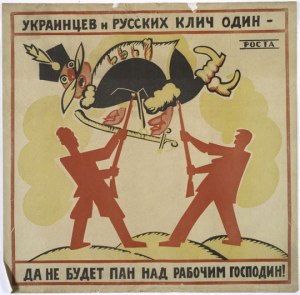 that there was a vast amount of material which could not be included. Despite this, articles on such topics as “the Great Russian” Trotsky, the Russian Civil War and the Bolsheviks continued to flourish.[14] After the death of Tsar Nicholas II the Voice declared that “No criminal in history has better earned his fate,” but lamented that “Nicholas dies and [William Martin] Murphy lives.”[15] This gives an idea of the demand that existed among the Voice’s readers for socialist politics.
that there was a vast amount of material which could not be included. Despite this, articles on such topics as “the Great Russian” Trotsky, the Russian Civil War and the Bolsheviks continued to flourish.[14] After the death of Tsar Nicholas II the Voice declared that “No criminal in history has better earned his fate,” but lamented that “Nicholas dies and [William Martin] Murphy lives.”[15] This gives an idea of the demand that existed among the Voice’s readers for socialist politics.
The Voice is a very interesting paper to look back over, with ads for pamphlets by Lenin and Zinoviev beside ads for the Republican leader Harry Boland’s shop in Dublin. Available in the Dublin City Library archives on Pearse Street, you get an exciting sense while reading it that you are getting a glimpse of the great, tragically untold story of the Irish working class.
The World Revolution and the Limerick Soviet
![hungarianmap[1]](https://ranksavagespit.files.wordpress.com/2013/12/hungarianmap1.jpg?w=300&h=221) The Voice issue for November 16th hailed the revolutions in Germany and Austria. The issue of January 11th included a full-page article on the idea of a General Strike and of Soviet power. The Belfast engineering strike, the Dublin tailors’ “Soviet” and the Monaghan asylum “Soviet” were all given great attention alongside the German Revolution, the Munich räterepublik and “The Red Hungarian Republic.”
The Voice issue for November 16th hailed the revolutions in Germany and Austria. The issue of January 11th included a full-page article on the idea of a General Strike and of Soviet power. The Belfast engineering strike, the Dublin tailors’ “Soviet” and the Monaghan asylum “Soviet” were all given great attention alongside the German Revolution, the Munich räterepublik and “The Red Hungarian Republic.”
Amid all this excitement, when it seemed that revolution was sweeping across Europe in an unstoppable wave, an article was published in the April 12th 1919 issue entitled “The Dictatorship of the Irish Proletariat.” This unsigned article addressed the military repression proposed by the British politician Ian McPherson. It continued:
Today the Soviet idea is sweeping westward over Europe […] Before long the whole tribe of which McPherson is but a specimen will be swallowed up by the great ocean which is flooding the continent […]
Again we say that Ireland’s best and most effective answer is the immediate establishment of Soviets, the instruments which will bring about the dictatorship of the Irish proletariat.
That must be the outcome of all the travail of these five years [since the 1913 lockout]. We have had enough of the old isolation. We have been cut off long enough from the mainstream of European life and thought.[16]
These words did not fall into a void. The next issue led with an article entitled “The Limerick Strike: Down Tools Against Tyranny.” The Limerick Soviet had been declared.
Limerick had three thousand ITGWU members, so the Voice must have seen a high circulation there.[17] On May Day 1918 7,000 workers from 42 different unions marched through the city. 15,000 then attended a demonstration at which speakers especially endorsed the Voice. With red flags waving, it was resolved
that we, the workers of Limerick and district, in mass meeting assembled, extend fraternal greetings to the workers of all countries, paying particular tribute to our Russian comrades who have waged such a magnificent struggle for their social and political emancipation.[18]
The links between Limerick, the Russian Revolution and the Voice are clear to see. The Limerick Soviet was no accident or anomaly; it was a natural manifestation of the growing working-class militancy, confidence and identification with Bolshevism.
The leadership miss the “occasion” for rebellion
The Irish Trade Union Congress leadership lied to members that national action was planned in order to de-escalate the strike. The later “Soviet” movement of distinctly Bolshevik workplace occupations took place on the initiative of local organisers, including one who had been prominent in Limerick during the Soviet, and owed little to the national leadership. At the Labour conference in August 1919, despite some dissenting voices, delegates agreed that it was right to cut the legs out from under the Limerick Soviet because it was “not the occasion” for “insurrection”.[19]
Many leadership figures falsely claimed that the only alternative to the betrayal of the Limerick Soviet which they engineered was a full-scale insurrection. Their own poverty of ideas stood out very clearly with their ridiculous proposal to evacuate the entire city as a form of protest – they sought any alternative, however desperate, to escalating the struggle and taking on imperialism.
Among those who spoke against the “insurrection” was Walter Carpenter, who had fought in Easter Week 1916. The tragedy is that while insurrection was indeed premature in 1916, when Carpenter did take up arms, it was what the situation demanded in 1919-20, when Carpenter’s feet were much colder. The only question was who was to lead the struggle.
The Labour leadership, despite their fighting words in their paper, ran a mile and left a clear field for the middle-class and capitalist elements in the form of Sinn Féin. These bourgeois nationalists seized the leadership in the struggle against imperialism
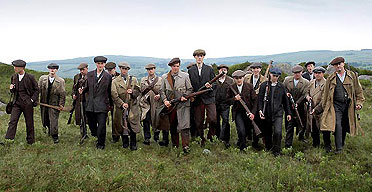
A scene from The Wind that Shakes the Barley, showing the insurrection that was beginning even as the leaders of Irish labour insisted that it was “not the occasion”
but only because the labour leadership would not take what was being handed to them. By late 1919 a guerrilla war was under way. In 1920 and 1921 it grew in scale and intensity. And in summer 1919 the Labour leadership had said it was “not the occasion” for revolution. In fact it was the most ripe “occasion” in Ireland in the whole twentieth century.
An Alternative Struggle for Independence
A labour-led struggle for independence would have embraced every street and every village and made every site of oppression and exploitation a centre of resistance. What were “soviets” in name – in reality militant, politicized strikes – would have become soviets in fact: organs of working-class power capable of running society. This struggle would not have been confined to removing British rule – it would have settled with Irish exploiters like William Martin Murphy, the villain of 1913, as well. It would not have been confined to Irish Catholics. On the basis of workers’ solidarity the southern Irish working class could have linked up with militant workers in Belfast, on the Clyde, and given a new impulse to the struggle for socialism on a European scale.
We should take a moment to imagine an alternative War of Independence, fought with different weapons, by the majority of the people, splitting the republican movement on class lines and exposing the hostility of the church to the demands of ordinary people. Such a movement would have had the potential to win the support of both sections of the Northern Irish working class on the basis of the socialist politics.
Saying the working class could have taken the lead in the struggle is not speculation. It had led the anti-conscription campaign of
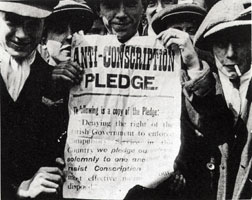 1918 and left Sinn Féin in the shade. A magnificent general strike beat the conscription bill and radicalised the country, all while the Republican leaders were still in prison with their organisations in disarray.
1918 and left Sinn Féin in the shade. A magnificent general strike beat the conscription bill and radicalised the country, all while the Republican leaders were still in prison with their organisations in disarray.
How could things have turned out differently?
Of course many Irish workers, including many of the most militant, had nationalist and republican ideas. A meeting of railway workers in 1918 voiced opposition to Labour running in elections at a time when the leadership was for it. It was this section which the leadership leaned on and encouraged.
But a real working-class leadership would have put forward an independent position clearly. An example comes in the form of Jim Larkin, who though confined to the United States, wrote with fury about the sell-out of Labour to Sinn Féin. A far-from-perfect figure, Larkin was nonetheless a proletarian leader who was head, shoulders and chest above those the workers’ movement was saddled with at the time, and he saw clearly what was happening.
We can imagine that a revolutionary party that kept an independent line and was critical of republicanism and the church would have lost some support early on and come under attack from all quarters. But once the class went through the experience of betrayal – the general election sell-out, the Limerick Soviet, the increasingly anti-working class position of the Dáil – they would win back this support tenfold. Such a situation would be clearly analogous to what the Bolsheviks did between February and October 1917.
Revolutionary socialism is based on a belief in the working class. When the time is ripe the best elements of the class can come to the fore, small wheels turning big wheels, the leadership winning over the class, the class realising its own power and making history. All this is conditional on the most advanced sections of the working class being organised ahead of time in a revolutionary party.
Perhaps Johnson and others were genuinely enthused and temporarily radicalised by the Russian Revolution.[20] Cathal 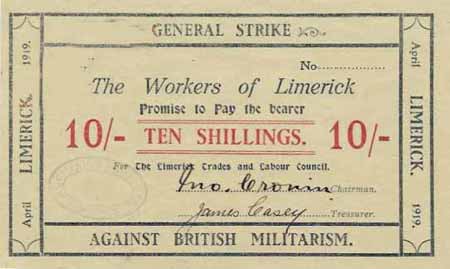 O’Shannon, editor of the Voice, the most left-wing of the leadership, rationalised and justified his colleagues’ behaviour in ridiculously over-optimistic terms: “the triumph of the Irish working class was bound up with the triumph that was coming, yea, had to come to the Bolsheviks in Russia.”[21] No need to escalate the Limerick Soviet – the European proletariat would do the job without an Irish worker having to lift a finger! Another explanation is that in a period of unprecedented, unexpected militancy they postured in order to please their membership.[22] A combination of the above factors is probable, and in the context of the European labour movement, normal enough.
O’Shannon, editor of the Voice, the most left-wing of the leadership, rationalised and justified his colleagues’ behaviour in ridiculously over-optimistic terms: “the triumph of the Irish working class was bound up with the triumph that was coming, yea, had to come to the Bolsheviks in Russia.”[21] No need to escalate the Limerick Soviet – the European proletariat would do the job without an Irish worker having to lift a finger! Another explanation is that in a period of unprecedented, unexpected militancy they postured in order to please their membership.[22] A combination of the above factors is probable, and in the context of the European labour movement, normal enough.
By contrast, many Limerick workers, particularly ITGWU members, felt betrayed by the calling-off of the strike. They organised a meeting and a blockade of Thomondgate Bridge on the day the partial return to work was declared.[23] This is not surprising; the context of the Limerick Soviet, as seen in the Voice and on May Day 1918, reveals that many Limerick workers saw the use of the term “Soviet” not just as a gimmick but as a link to the seemingly all-conquering international revolutionary movement. Again, if a strong revolutionary organisation had existed, with an ability to spread its own material and its own ideas, it could have won a lot of support from these workers and explained the betrayal for what it really was.
Instead what happened was that Ireland’s most militant workers fell into inactivity and demoralisation or support for the republicans, who were actually fighting British imperialism. An example presents itself in the form of one man. In 1919 Peadar O’Donnell was an outstanding ITGWU organiser but by 1922 he was in the IRA.
The ILP & TUC and ITGWU despite their praise for Bolshevism stood with the “centrist” trend in the Second International, which was to the right of the Bolsheviks and to the left of the pro-war parties. This grouping came together in February 1919 with the Berne “two-and-a-half” International which O’Shannon and Johnson attended.[24]
The Irish labour leadership was therefore not remarkable in its conservatism; it was in fact on the left wing at the Berne congress, championing the Bolsheviks and the idea of dictatorship of the proletariat as opposed to parliamentary democracy.[25] For a time they even tried to join the revolutionary Third International.
O’Brien, Johnson, O’Shannon – the leading figures in Irish labour during this period – were not as horrifically treacherous as the likes of the SPD in Germany. They did not gun workers down in the streets. They did not disgrace themselves with anti-Bolshevik red-baiting. What they did, they did well. But revolutionary action, which the situation demanded, was beyond them. To occupy an independent class position, across national and sectarian lines, to frustrate Republicanism and defy the Catholic Church, was a task for revolutionaries.
Fundamentally their outlook was parliamentarian and industrial, a vision of a class struggle at the kind of slow, plodding, gentle pace which real-life history has never allowed. They were a non-revolutionary leadership thrust into a revolutionary situation. Often revolutionary in words, but capable of outrageous conservatism in deeds, 1917-1923 must have been in their memory an exciting interlude, or an incomprehensible hiccup, before Labour’s long back-seat in the 20th century’s “independent” Ireland. Maybe this pace of events was more comfortable for them.
It is said that when the never-implemented “Democratic Programme” (at the time the words “democracy” and “socialism” were often interchangeable) was adopted by the first Dáil as a sop to the labour movement and to pay back the Labour Party for not running in the 1918 election, tears came to the eyes of Thomas Johnson. His tears of joy were, just to recap, over a document with no binding content read aloud in a bourgeois parliament as a thank-you for the working class laying down its weapons.
By contrast, the class they led made a great contribution to history, and acted out what should have been just the first chapter in a greater story. The Irish general strikes of this period were the awe of Europe’s labour movement. The Irish Soviets deserve a place of honour alongside the other “Western Soviets” of the Scotland, Germany, Italy and elsewhere. Throughout all these struggles the red flag flew, “The Internationale” and “The Red Flag” echoed, and words never-before heard in Ireland like “Bolshevik” and “Soviet” took on a great importance. The Irish proletariat played an outstanding role in the World Revolution.
[1] Conor Costick, Revolution in Ireland: Popular Militancy 1913-1923 (Cork University Press, 218)
[2] Tom Barry, Guerrilla Days in Ireland, (Anvil Books, 1949) and Ernie O’Malley, On Another Man’s Wound (Dublin & London, Rich & Cowan, 1936) are the classic accounts of the period from the point of view of IRA leaders. These are very readable and useful accounts, especially O’Malley’s, but their focus is quite narrow.
[3] See for example Tökés, 227
[4] Cork Workers’ Club, Irish Labour and its International Relations in the era of the Second International and the Bolshevik Revolution, 38
[5] Sondhaus, 291
[6] As argued, for instance, by David Fitzpatrick, Politics and Irish Life, 210
[7] Dan Bradley, Farm Labourers: Irish Struggle 1900-1976 (Athol Books 1988), 55
[8] Bradley, 60-66
[9] Connacht Tribune, May 10th, 1919
[10] Eg, Irish Independent, May 5th, 1919
[11] Voice of Labour, March 2nd, 1918
[12] Voice of Labour, January 20th, 1918
[13] Ibid., February 23rd, 1918
45 Voice of Labour, April 20 1918
[15] Voice of Labour, August 24th 1918
[16] Voice of Labour, April 12th 1919
[17] Liam Cahill, Forgotten Revolution: Limerick Soviet 1919, O’Brien, 1990, p 21; Voice of Labour, March 2 1918
[18] Voice of Labour, May 11th, 1918
[19] Ibid, 132-135
[20] “…excited by the energy and influence of their movement, some began to dream of social revolution.” Fitzpatrick, Politics and Irish Life, 209
[21] Costick, p 88
[22] See O’Connor, Syndicalism in Ireland 1917-1923, Cork University Press (1988)
[23] Cahill, 141
[24] Voice of Labour, February 9th 1918
[25] Cork Workers’ Club, International Relations¸ 49
